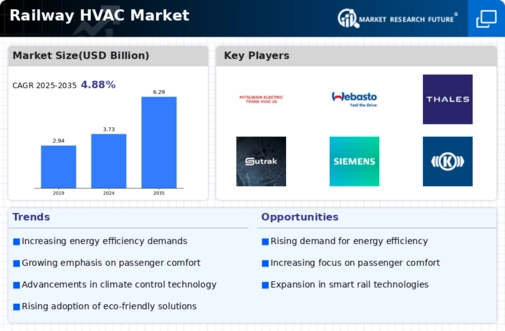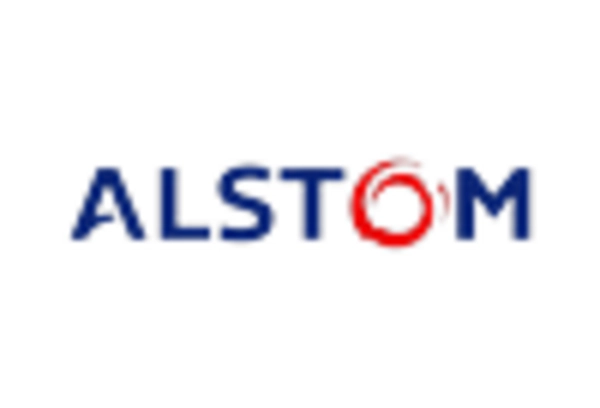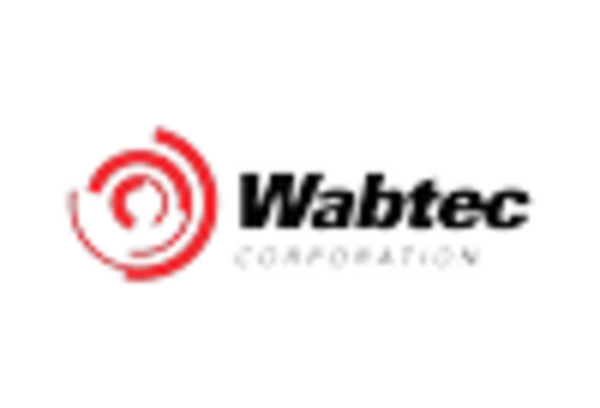Passenger Comfort and Safety
In the Railway HVAC Market, passenger comfort and safety remain paramount. As rail travel becomes increasingly popular, operators are investing in HVAC systems that ensure a pleasant environment for passengers. This includes maintaining optimal temperature and air quality within train compartments. Recent studies indicate that well-designed HVAC systems can significantly enhance passenger satisfaction, leading to increased ridership. Furthermore, safety features such as air filtration systems that remove harmful particles and pathogens are becoming standard. This focus on comfort and safety not only improves the travel experience but also aligns with broader trends in public transportation, where customer experience is a key differentiator. As a result, the demand for advanced HVAC solutions that prioritize these aspects is likely to grow.
Growth of Urban Rail Networks
The Railway HVAC Market is benefiting from the expansion of urban rail networks across various regions. As cities strive to improve public transportation and reduce traffic congestion, investments in rail infrastructure are increasing. This growth in urban rail systems necessitates the installation of efficient HVAC systems to ensure passenger comfort and safety. Recent projections suggest that urban rail networks will see a compound annual growth rate of over 5% in the coming years. Consequently, the demand for reliable and effective HVAC solutions is expected to rise, as operators seek to enhance the travel experience for commuters. This trend not only supports the growth of the Railway HVAC Market but also aligns with broader urbanization trends, where efficient public transport systems are essential.
Regulatory Pressures and Standards
The Railway HVAC Market is significantly influenced by regulatory pressures and standards aimed at improving environmental sustainability and safety. Governments and regulatory bodies are increasingly implementing stringent guidelines that require rail operators to adopt more efficient and environmentally friendly HVAC systems. Compliance with these regulations not only helps in reducing the carbon footprint of rail operations but also enhances the overall safety of the railway environment. For instance, regulations may mandate the use of specific refrigerants that have lower global warming potential. As a result, manufacturers are compelled to innovate and adapt their HVAC solutions to meet these evolving standards, thereby driving growth in the market. This regulatory landscape is likely to continue shaping the future of the Railway HVAC Market.
Increasing Demand for Energy Efficiency
The Railway HVAC Market is experiencing a notable shift towards energy-efficient systems. As rail operators seek to reduce operational costs and environmental impact, the demand for HVAC systems that utilize less energy is on the rise. According to recent data, energy-efficient HVAC systems can reduce energy consumption by up to 30% compared to traditional systems. This trend is driven by both economic considerations and regulatory pressures aimed at reducing carbon emissions. Consequently, manufacturers are innovating to develop advanced HVAC solutions that not only meet these energy efficiency standards but also enhance passenger comfort. The integration of smart technologies further supports this trend, allowing for real-time monitoring and optimization of energy use within railway systems.
Technological Innovations in HVAC Systems
The Railway HVAC Market is witnessing rapid technological advancements that are reshaping the landscape of HVAC systems. Innovations such as IoT integration, predictive maintenance, and advanced climate control technologies are becoming increasingly prevalent. These technologies enable real-time data collection and analysis, allowing for more efficient operation and maintenance of HVAC systems. For instance, predictive maintenance can reduce downtime and extend the lifespan of HVAC equipment, which is crucial for rail operators. Moreover, the introduction of modular HVAC systems offers flexibility and scalability, catering to various train types and configurations. As these technologies continue to evolve, they are expected to drive further growth in the Railway HVAC Market, enhancing both operational efficiency and passenger experience.


















Leave a Comment